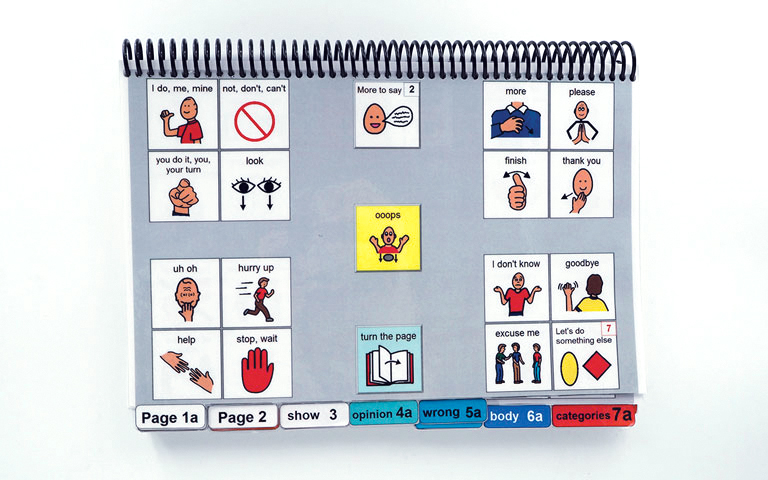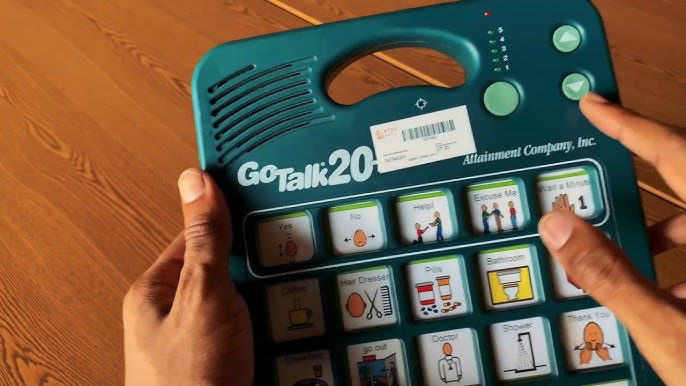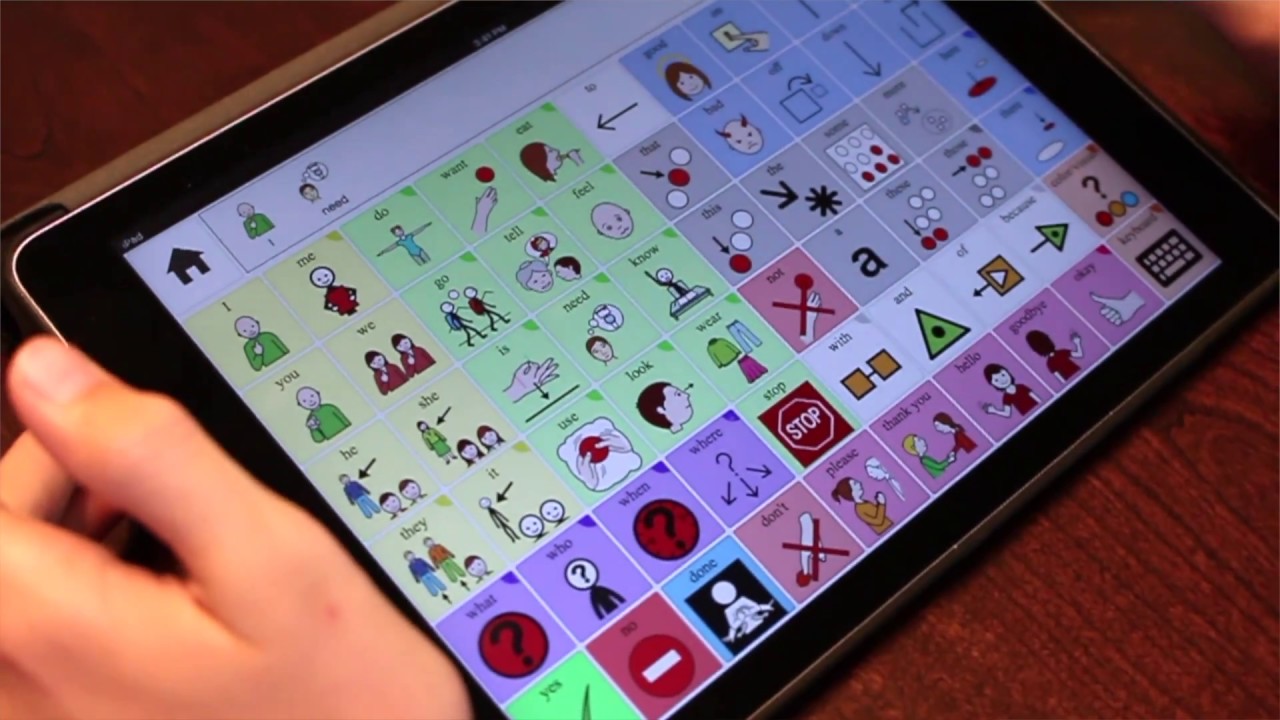AAC at Home
Resources to helped loved ones and caregivers of AAC users
Topics
- AAC Basics
- Being a Good Communication Partner
- School Coordination
- Online Communities
- Working Toward Independence
AAC Basics
Augmentative and Alternative Communication (AAC) is actually a whole category of different kinds of tools and strategies. The main purpose of AAC is to help people express themselves when they may not always be able or comfortable using their natural voice. AAC can also help people develop a deeper understanding of language, and make it easier for them to express themselves. AAC is often printed on paper, activated by buttons that speak, or organized on a tablet or phone for more advanced speech output.
AAC empowers individuals to convey their thoughts, needs, and emotions, which can lead to improved language development. It can serve as a bridge to gradually transition from non-verbal or limited verbal communication to more robust language skills, promoting social interaction and emotional well-being. Overall, AAC is a valuable resource that fosters language growth and enhances the quality of life for individuals with communication difficulties.
With the aid of AAC, many individuals enjoy full and productive lives, able to respond to questions and communicate independently throughout their days.
Here’s a list of some AAC options across different categories:
High Tech AAC
- Tablet-Based AAC Systems: Specialized software running on tablets that can be customized for individual needs.
- Communication Apps: Apps installed on tablets or smartphones with text-to-speech functionality, such as Proloquo2Go or TouchChat.
- Eye-Tracking AAC Systems: Devices that track eye movement to select symbols or words on a screen.
- Alternative Access Apps: For those physically unable to use the touchscreen, SGDs offer flexible access options including: Eye-gaze Head tracking Joystick and alternative mouse control Single and multiple switch control Thus, even children with severe physical disabilities can operate a life-changing AAC device.
Pros:
|
Cons:
|
It's important to remember that the choice of AAC system depends on an individual, everyone has different needs, preferences and abilities. Professional consultants like speech-language pathologists can provide an assessment, which will help in selecting the most appropriate AAC solution for each person. Additionally, the field of AAC continues to evolve with advancements in technology, so new solutions may become available over time.
Being a Good Communication Partner
“Communication Partner” is a term you may hear used by therapsists or teachers, but all it really means is “someone to talk with”. If your child or sibling uses AAC, they may not get as many chances to interact as their peers, but that doesn’t mean you can’t have meaningful connections with them. Here are a few things to keep in mind when talking with someone who uses AAC.
Respond to What They Say. Sometimes we all say thing that are off-topic – that’s part of what makes communication so interesting! If your family member says something where you don’t undertand what they mean, it’s ok to tell them that. You can also respond to what you think they might possibly mean. Occasionally you could ask them for clarification, but just remember that overloading the conversation with questions can get tiring and frustrating.
It’s Ok if They Don’t Say Anything. It can take time and work to come up with a response using AAC. First you need to think of what you want to say, then you need to think of what words you have available that would get your point across, then you have to navigate to and select those words in order. Sometimes it’s not worth it, it’s not doable, or you don’t know how. Give your family member time to respond, but also don’t be afraid to move on if they don’t have something to say. If they give permission, you could also show them examples of how you might respond if you were them.
Not Everything is On the AAC. AAC systems can be unique and interesting, and we may be tempted to try to get someone to exclusively use their AAC for all communication. But all of us use different tools to communicate. It’s ok to laugh or grunt as a response, and smiling or frowning are perfectly acceptable answers to questions. If you think you know what your family member means, don’t force them to “use your talker” before you’ll respond to them. If they are still learning, and you have permission, you might sometimes show them how they could have responded using AAC.
Don’t Force Control. Sometimes it feels like asking questions is the only way to make conversation, especially if the other person isn’t saying much. But you’d probably get frustrated if all your communication was just answering other people’s questions. Mix it up by sharing what’s happened in your day, using phrases like “I wonder” or “I was thinking”, or letting there be quiet pauses. If your family member says something using AAC, don’t be afraid to change to that subject, everyone deserves practice in driving the converastion.
If you want to learn more, here’s a great article with some tips for how to up your game as an AAC communication partner.
School Coordination
Most AAC users in a school setting have an individualized plan for their education (called an IEP in the United States). This means that the school is required to meet at least annually, and as requested by the family, to discuss what accommodations can best help the student succeed in their education. Think of ways the student can be part of these discussions and can drive their own learning experience.
One of the best indicators of success in AAC adoption is engagement by the AAC user’s support group. When support is consistent both at school and at home, AAC use has a better chance of becoming regular and effective. Some schools are better than others at this, so you may need to take the lead and ensure that access to AAC is consistent, and everyone is modeling and providing positive, healthy interactions with the AAC system.
Online Communities
 AAC - Alternative Awesome Communicators
AAC - Alternative Awesome Communicators
 AAC Through Motivate, Model, Move Out Of The Way
AAC Through Motivate, Model, Move Out Of The Way
 Ask Me, I’m An AAC User!
Ask Me, I’m An AAC User!
(note that this community has very specific rules that need to be followed before posting)
Working Toward Independence
There are many different levels of independence, and all of them are strengthened through communication. Historically there have been many factors at play that have resulted in AAC users feeling disempowered and unable to control their own lives, but you can be part of helping change this for the better.
If you are helping someone who uses AAC, you can make sure to respect them enough to include them in decisions and plans that will affect them. As their communication skills and autonomy will likely change over time, it’s a good idea to stop and check regularly if you’re giving them as much independence as possible, and that matches their current age and circumstances.
You can also help teach people around the AAC user how to interact appropriately. Try to give your family member time to respond before you step in to help, and encourage people to talk directly to them rather than to you when you’re out and about together.
See our Transition Resources page for more information on the transition from school to community.
 Utah Center for AAC Excellence
Utah Center for AAC Excellence

